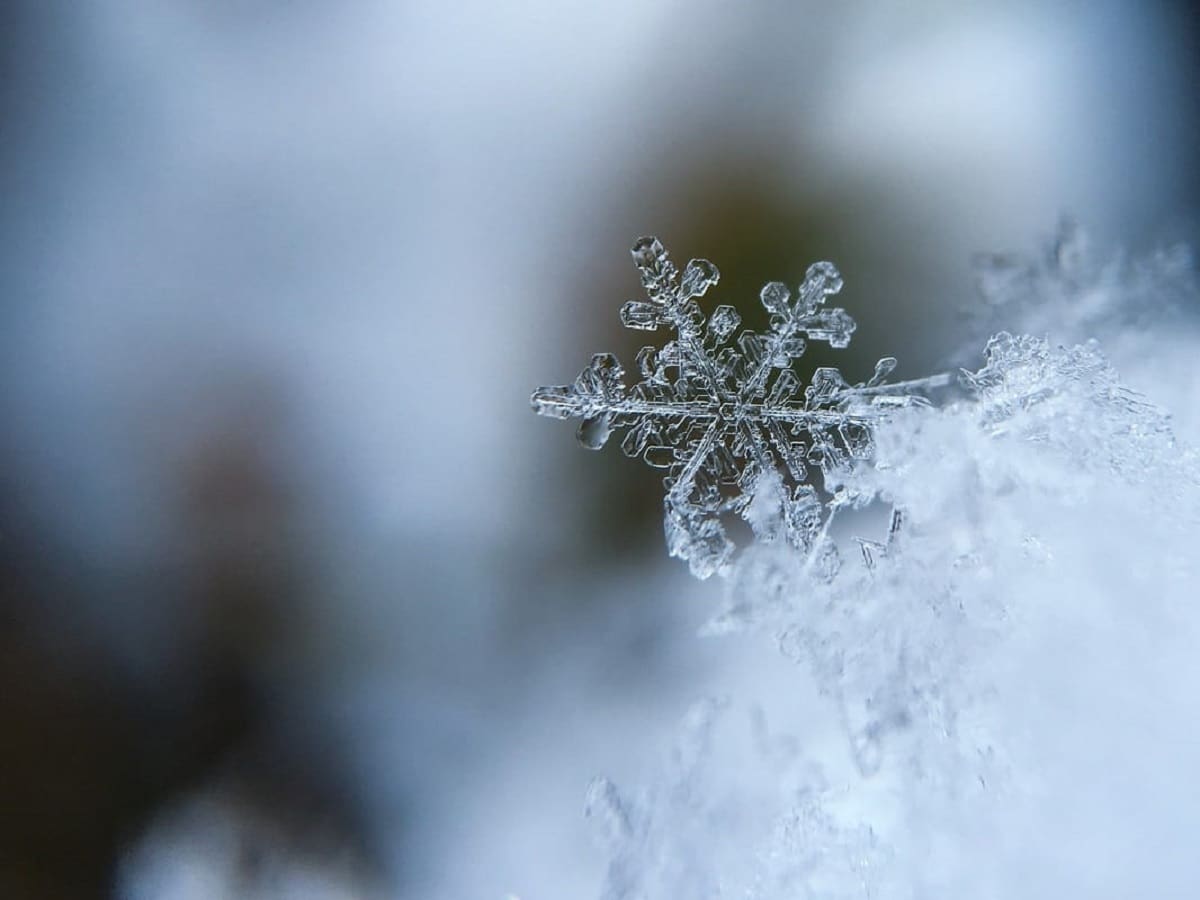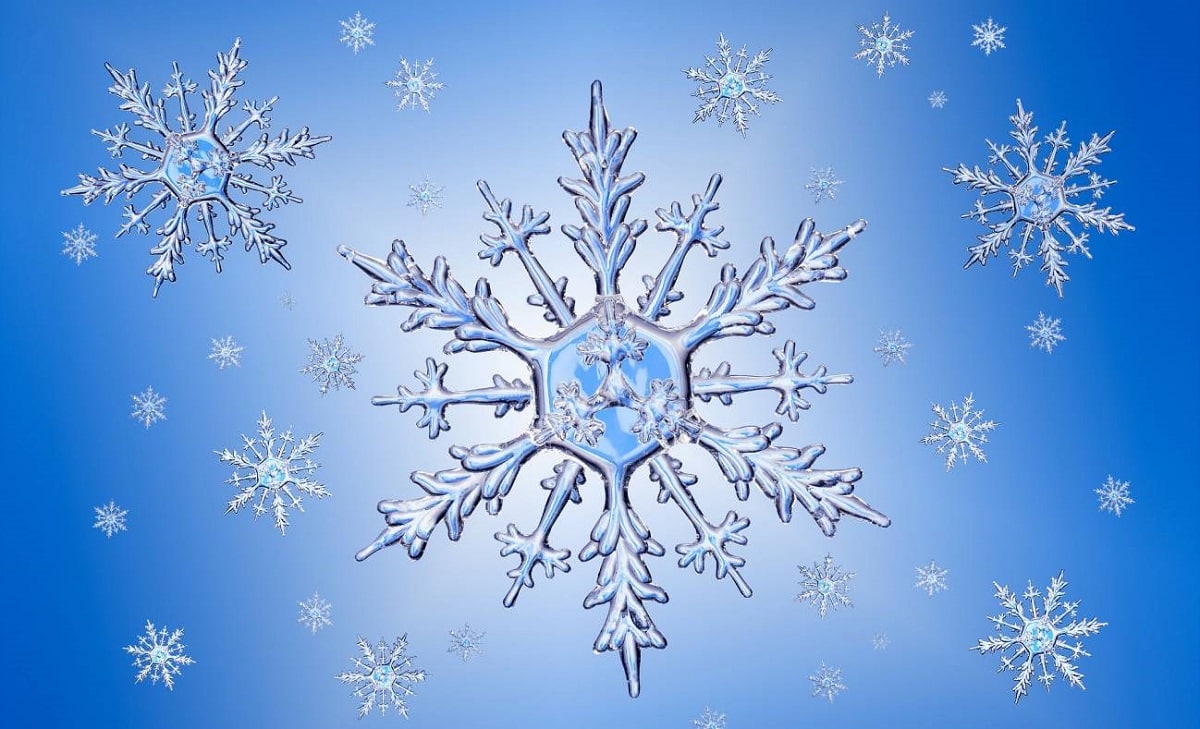
The ice crystals They have always been the object of study by scientists given their peculiar and striking shape. If we look at them under a microscope we can see that they have spectacular geometric shapes and it is striking why these geometric shapes are generated in nature.
In this article we are going to tell you what the conclusions of various studies related to ice crystals are and what has been discovered to date.
formation of ice crystals

The highly symmetrical shape is due to reservoir growth, where water is deposited directly on ice crystals and evaporates. Depending on the ambient temperature and humidity, ice crystals can develop from the initial hexagonal prisms in many symmetrical ways. The possible shapes of ice crystals are columnar, needle-shaped, plate-shaped, and dendritic. If the crystal migrates to a region of different environmental conditions, the growth mode may change and the final crystal may show mixed modes.
Ice crystals tend to fall with their long axes aligned horizontally, and thus are visible on polarimetric weather radars with enhanced (positive) differential reflectance values. Ice crystal loading can cause alignments other than horizontal. Polarized weather radar can also detect charged ice crystals well. Temperature and humidity determine many different crystal forms. Ice crystals are responsible for several atmospheric optical manifestations.
Frozen clouds are made of ice crystals, especially cirrus clouds and freezing fog. Ice crystals in the troposphere cause the blue sky to turn slightly white, which could be a sign of an approaching front (and rain) as moist air rises and freezes into ice crystals.
At normal temperature and pressure, water molecules are V-shaped and two hydrogen atoms are bonded to oxygen atoms at an angle of 105°. Common ice crystals are symmetrical and hexagonal
When compressed between two layers of graphene, square ice crystals form at room temperature. The material is a new ice crystal phase that combines with 17 other ices. The research follows on from an earlier discovery that water vapor and liquid water can pass through sheets of laminated graphene oxide, unlike smaller molecules like helium. This effect is thought to be driven by van der Waals forces, which can involve pressures in excess of 10.000 atmospheres.
studies on ice crystals

Simulations carried out on the MareNostrum supercomputer in Barcelona by researchers from the CSIC and the Complutense University of Madrid have confirmed that the key to the strange growth of ice crystals lies in their surface structure
Ice surfaces can be in three different states, with varying degrees of disorder. Passages from one to the other create abrupt changes in growth rates as temperatures rise and explain the different ways (flattened, hexagonal, or both) from ice or snow crystals in the atmosphere.
The key to these specific crystal changes and growth is their surface structure. A study carried out by researchers Luis González MacDowell from the Complutense University of Madrid (UCM), Eva Noya from the Rocca Solano Institute of Physical Chemistry (IQFR) of the High Commissioner for Scientific Research and Pablo Llombart from both institutions demonstrates this somewhat. . The article was published in the journal Science Advances.
"The reason for this change has been a mystery until now," says González MacDowell, recalling that the Japanese researcher Ukichiro Nakaya discovered in the 1930s the smallest ice crystals, called diamond dust, shaped like a hexagonal prism. These prisms can be flat, like a lozenge, or elongated, like a pencil or hexagonal prism, and can transform from one shape to another at a specific temperature.
Simulations

The researchers observed that at low temperatures, the ice surface was smooth and relatively orderly. When the vapor molecules collide with the surface, they can't find a place to rush in and quickly evaporate, which makes crystal growth very slow.
But at higher temperatures, the ice surface becomes more disordered, with many steps. Vapor molecules can easily find their place on the steps and crystals grow rapidly.
"We observed that this change was not gradual, but occurred due to a very specific transition called a topological transition. But what made the ice even more unusual was that all of a sudden, when the outer shell of the crystal melted, the surface is smoother and messier again," Noah said.
When it becomes very smooth again, crystal growth becomes very slow on that side of the crystal, but not on the other side. Suddenly some grow fast, others grow slowly, and the shape of the crystals changes, as Nakatani observed in experiments more than 90 years ago.
Simulation in MareNostrum
Given that ice is a complex substance that needs to be studied using experimental techniques due to its rapid evaporation, simulations have been carried out for eight months on the largest computer in Spain, MareNostrum (BSC-CNS).
“The computational work has allowed us to determine the path of each water molecule that forms the crystal; but of course, to form a small crystal, we need hundreds of thousands of molecules, so the amount of computation required to do this study is enormous. says Llombart Say.
González MacDowell concluded that these results are “very interesting, but scientific research always needs to be confirmed by new calculations and validations. Despite this caution, we are pleased that our efforts have borne fruit in the form of interesting results, because it took many unsuccessful attempts to get funding.”
In addition, the chemist recalls that atmospheric snow crystals play an important role in global warming: “To understand the impact on climate change, we need to understand its shape and rate of growth. So our better understanding allows us to put another piece in the multi-million dollar puzzle."
I hope that with this information you can learn more about ice crystals and their characteristics.
The interesting and incredible themes that our mother nature presents us are to be valued, since they provide us with knowledge that the imagination enjoys... It is so pleasant to observe the ice crystals which resemble a work of art... Greetings